Practical Genetics: Mammalian Coat Color Determination Analysis
VerifiedAdded on 2023/06/03
|19
|4076
|395
Practical Assignment
AI Summary
This practical assignment focuses on understanding the genetics behind coat color determination in mammals, using mice as a primary example. It investigates the role of melanin, the influence of specific genes and their alleles, and the relationship between gene expression and phenotype. The assignment details various experimental procedures, including DNA extraction from blood, feathers, and muscle tissues, visualization of DNA products via agarose gel electrophoresis, and PCR amplification of the CHD1 gene. The practical aims to provide hands-on experience in molecular biology techniques and data analysis, ultimately determining the sex of the extracted samples based on PCR results. The results and discussion section emphasizes the relationship between migration rates and base pair lengths, highlighting the utility of semi-log plots in analyzing exponential ranges of fragment sizes, contributing to a deeper understanding of genetic inheritance and molecular diagnostics. Desklib provides access to this and other solved assignments.
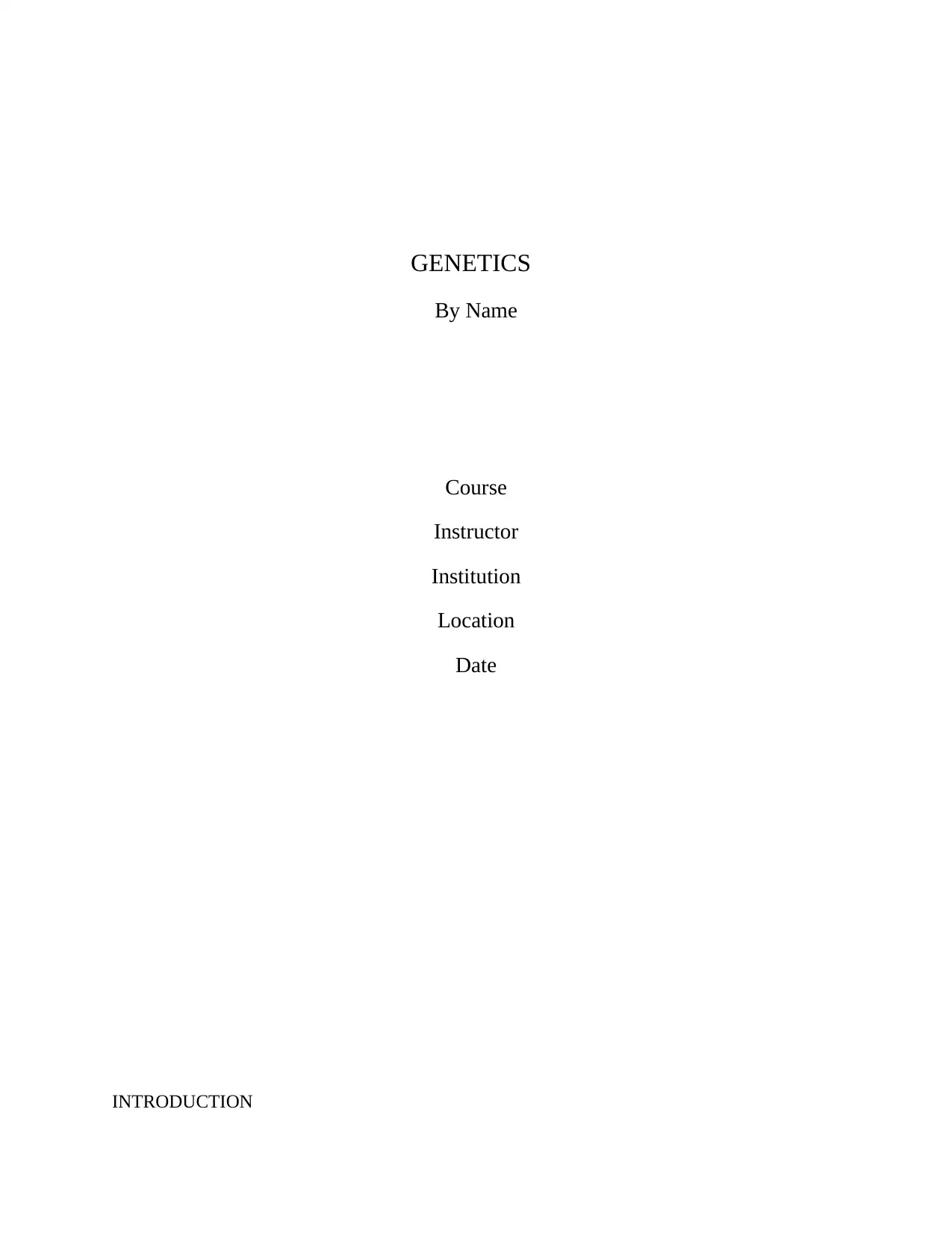
GENETICS
By Name
Course
Instructor
Institution
Location
Date
INTRODUCTION
By Name
Course
Instructor
Institution
Location
Date
INTRODUCTION
Paraphrase This Document
Need a fresh take? Get an instant paraphrase of this document with our AI Paraphraser
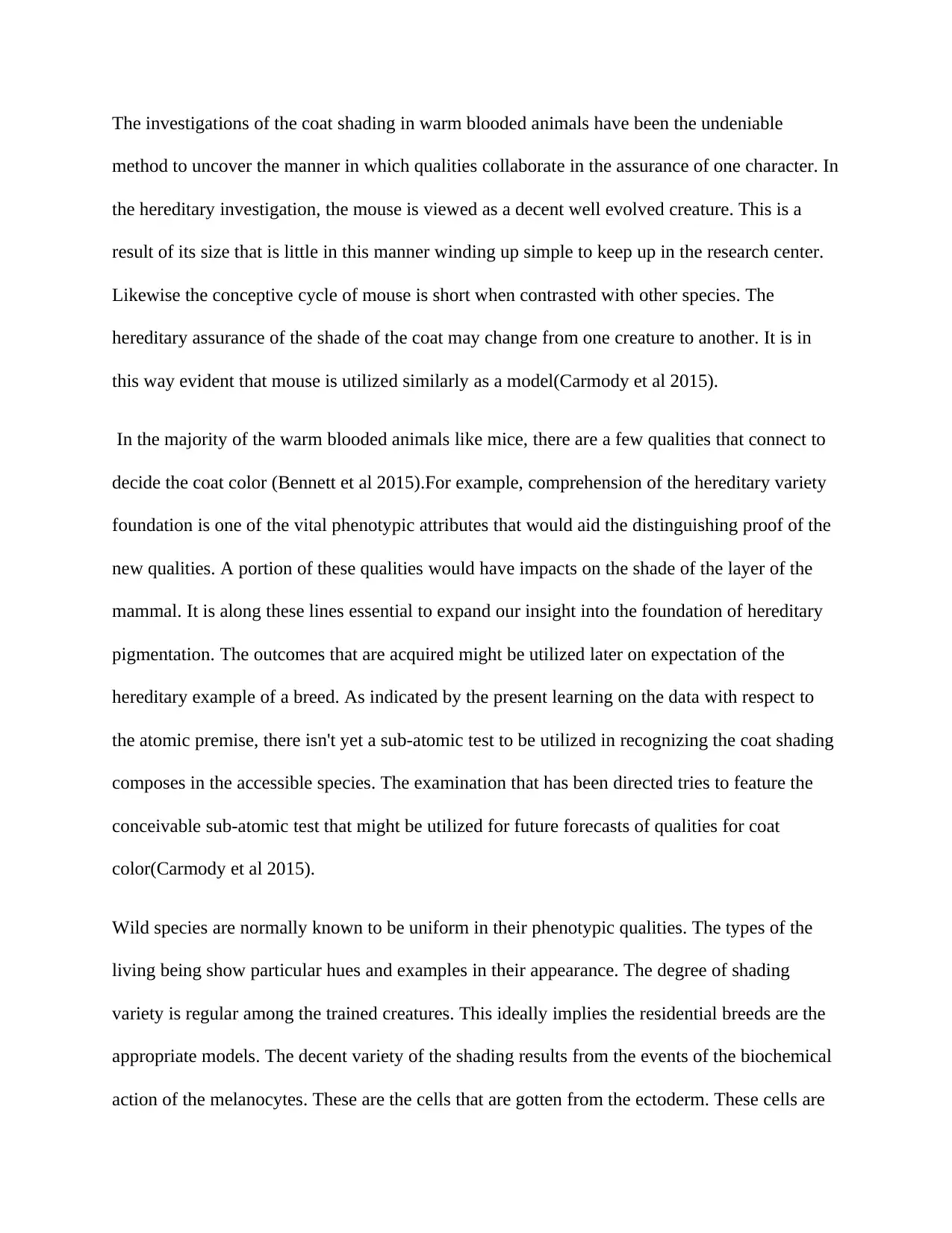
The investigations of the coat shading in warm blooded animals have been the undeniable
method to uncover the manner in which qualities collaborate in the assurance of one character. In
the hereditary investigation, the mouse is viewed as a decent well evolved creature. This is a
result of its size that is little in this manner winding up simple to keep up in the research center.
Likewise the conceptive cycle of mouse is short when contrasted with other species. The
hereditary assurance of the shade of the coat may change from one creature to another. It is in
this way evident that mouse is utilized similarly as a model(Carmody et al 2015).
In the majority of the warm blooded animals like mice, there are a few qualities that connect to
decide the coat color (Bennett et al 2015).For example, comprehension of the hereditary variety
foundation is one of the vital phenotypic attributes that would aid the distinguishing proof of the
new qualities. A portion of these qualities would have impacts on the shade of the layer of the
mammal. It is along these lines essential to expand our insight into the foundation of hereditary
pigmentation. The outcomes that are acquired might be utilized later on expectation of the
hereditary example of a breed. As indicated by the present learning on the data with respect to
the atomic premise, there isn't yet a sub-atomic test to be utilized in recognizing the coat shading
composes in the accessible species. The examination that has been directed tries to feature the
conceivable sub-atomic test that might be utilized for future forecasts of qualities for coat
color(Carmody et al 2015).
Wild species are normally known to be uniform in their phenotypic qualities. The types of the
living being show particular hues and examples in their appearance. The degree of shading
variety is regular among the trained creatures. This ideally implies the residential breeds are the
appropriate models. The decent variety of the shading results from the events of the biochemical
action of the melanocytes. These are the cells that are gotten from the ectoderm. These cells are
method to uncover the manner in which qualities collaborate in the assurance of one character. In
the hereditary investigation, the mouse is viewed as a decent well evolved creature. This is a
result of its size that is little in this manner winding up simple to keep up in the research center.
Likewise the conceptive cycle of mouse is short when contrasted with other species. The
hereditary assurance of the shade of the coat may change from one creature to another. It is in
this way evident that mouse is utilized similarly as a model(Carmody et al 2015).
In the majority of the warm blooded animals like mice, there are a few qualities that connect to
decide the coat color (Bennett et al 2015).For example, comprehension of the hereditary variety
foundation is one of the vital phenotypic attributes that would aid the distinguishing proof of the
new qualities. A portion of these qualities would have impacts on the shade of the layer of the
mammal. It is along these lines essential to expand our insight into the foundation of hereditary
pigmentation. The outcomes that are acquired might be utilized later on expectation of the
hereditary example of a breed. As indicated by the present learning on the data with respect to
the atomic premise, there isn't yet a sub-atomic test to be utilized in recognizing the coat shading
composes in the accessible species. The examination that has been directed tries to feature the
conceivable sub-atomic test that might be utilized for future forecasts of qualities for coat
color(Carmody et al 2015).
Wild species are normally known to be uniform in their phenotypic qualities. The types of the
living being show particular hues and examples in their appearance. The degree of shading
variety is regular among the trained creatures. This ideally implies the residential breeds are the
appropriate models. The decent variety of the shading results from the events of the biochemical
action of the melanocytes. These are the cells that are gotten from the ectoderm. These cells are
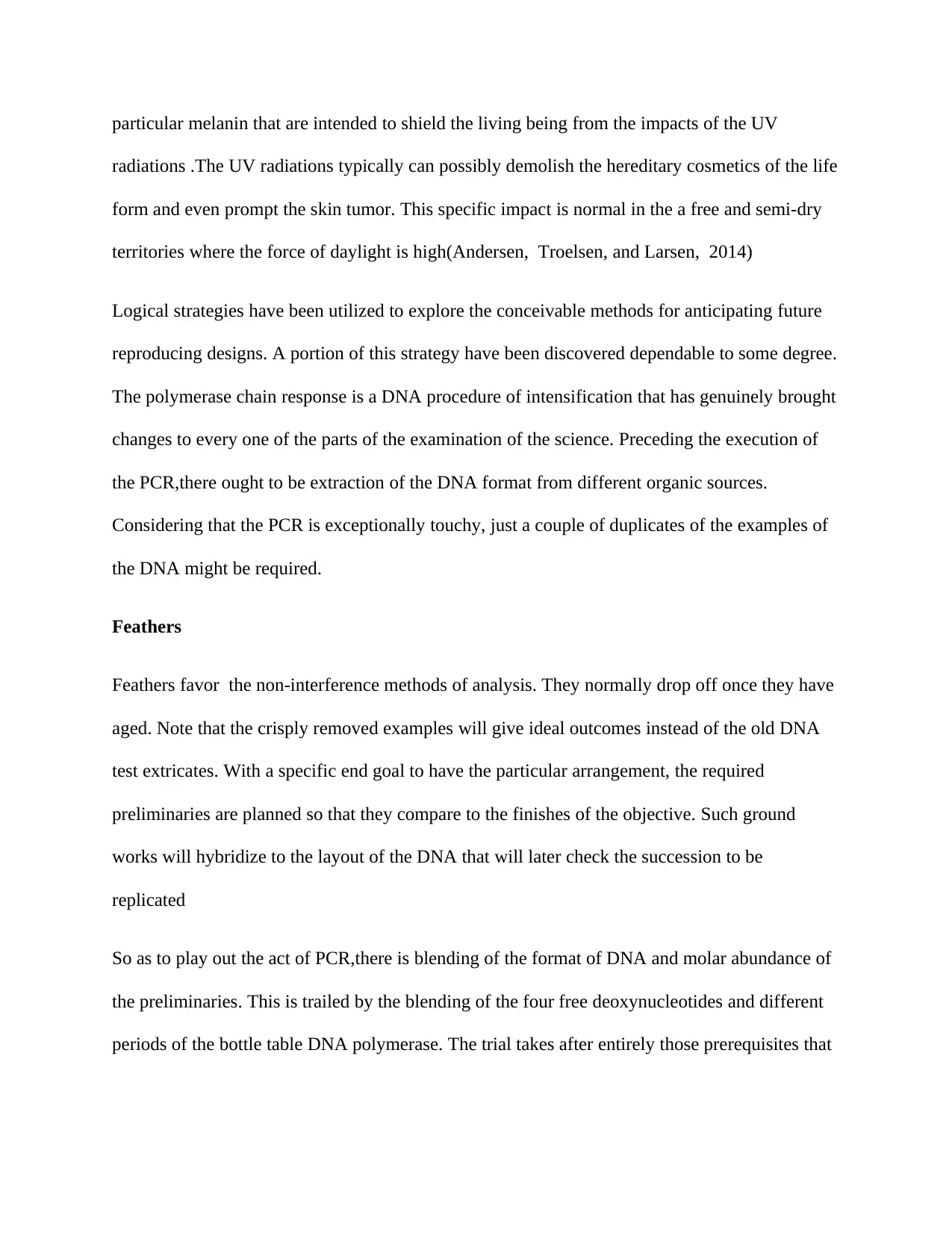
particular melanin that are intended to shield the living being from the impacts of the UV
radiations .The UV radiations typically can possibly demolish the hereditary cosmetics of the life
form and even prompt the skin tumor. This specific impact is normal in the a free and semi-dry
territories where the force of daylight is high(Andersen, Troelsen, and Larsen, 2014)
Logical strategies have been utilized to explore the conceivable methods for anticipating future
reproducing designs. A portion of this strategy have been discovered dependable to some degree.
The polymerase chain response is a DNA procedure of intensification that has genuinely brought
changes to every one of the parts of the examination of the science. Preceding the execution of
the PCR,there ought to be extraction of the DNA format from different organic sources.
Considering that the PCR is exceptionally touchy, just a couple of duplicates of the examples of
the DNA might be required.
Feathers
Feathers favor the non-interference methods of analysis. They normally drop off once they have
aged. Note that the crisply removed examples will give ideal outcomes instead of the old DNA
test extricates. With a specific end goal to have the particular arrangement, the required
preliminaries are planned so that they compare to the finishes of the objective. Such ground
works will hybridize to the layout of the DNA that will later check the succession to be
replicated
So as to play out the act of PCR,there is blending of the format of DNA and molar abundance of
the preliminaries. This is trailed by the blending of the four free deoxynucleotides and different
periods of the bottle table DNA polymerase. The trial takes after entirely those prerequisites that
radiations .The UV radiations typically can possibly demolish the hereditary cosmetics of the life
form and even prompt the skin tumor. This specific impact is normal in the a free and semi-dry
territories where the force of daylight is high(Andersen, Troelsen, and Larsen, 2014)
Logical strategies have been utilized to explore the conceivable methods for anticipating future
reproducing designs. A portion of this strategy have been discovered dependable to some degree.
The polymerase chain response is a DNA procedure of intensification that has genuinely brought
changes to every one of the parts of the examination of the science. Preceding the execution of
the PCR,there ought to be extraction of the DNA format from different organic sources.
Considering that the PCR is exceptionally touchy, just a couple of duplicates of the examples of
the DNA might be required.
Feathers
Feathers favor the non-interference methods of analysis. They normally drop off once they have
aged. Note that the crisply removed examples will give ideal outcomes instead of the old DNA
test extricates. With a specific end goal to have the particular arrangement, the required
preliminaries are planned so that they compare to the finishes of the objective. Such ground
works will hybridize to the layout of the DNA that will later check the succession to be
replicated
So as to play out the act of PCR,there is blending of the format of DNA and molar abundance of
the preliminaries. This is trailed by the blending of the four free deoxynucleotides and different
periods of the bottle table DNA polymerase. The trial takes after entirely those prerequisites that
⊘ This is a preview!⊘
Do you want full access?
Subscribe today to unlock all pages.

Trusted by 1+ million students worldwide
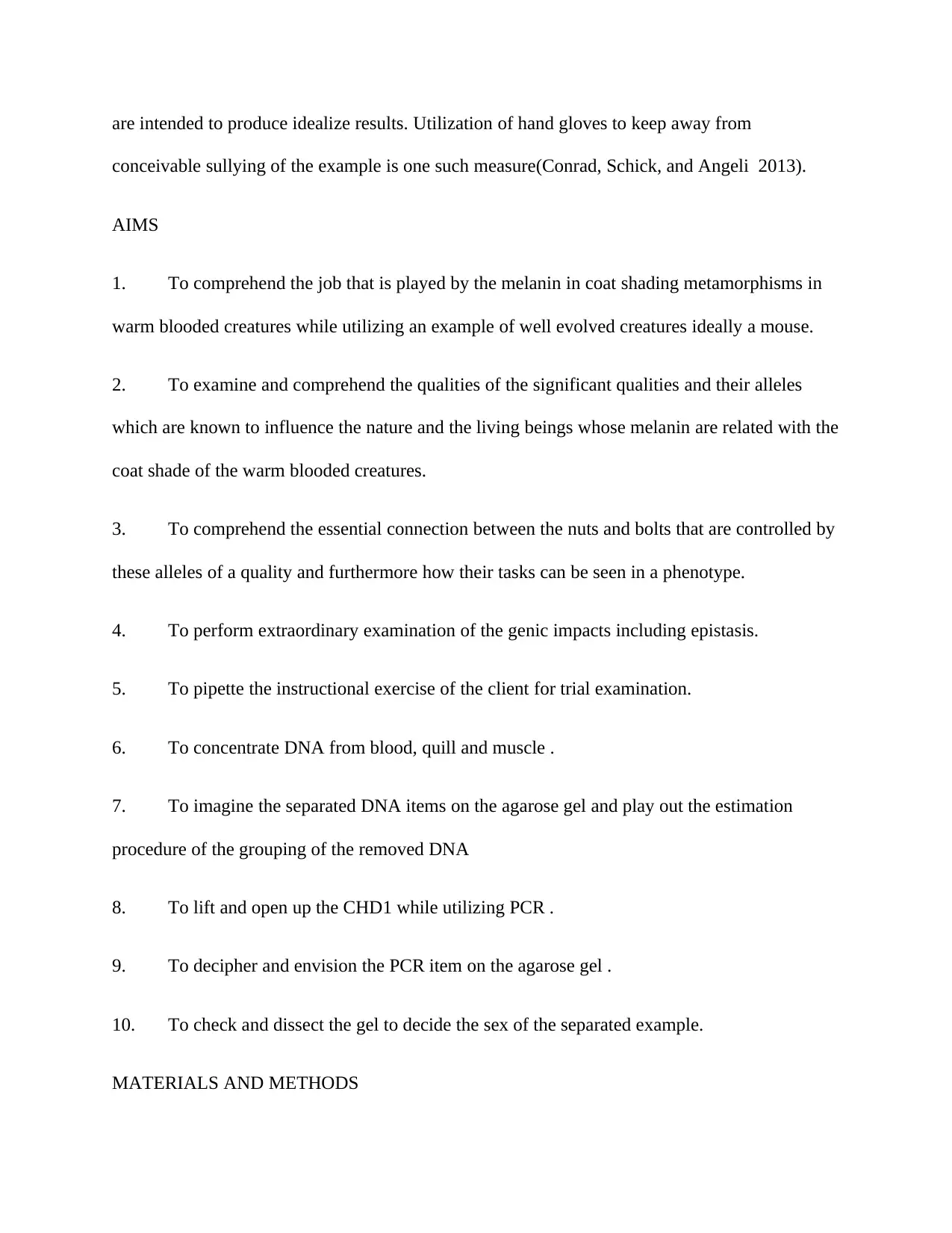
are intended to produce idealize results. Utilization of hand gloves to keep away from
conceivable sullying of the example is one such measure(Conrad, Schick, and Angeli 2013).
AIMS
1. To comprehend the job that is played by the melanin in coat shading metamorphisms in
warm blooded creatures while utilizing an example of well evolved creatures ideally a mouse.
2. To examine and comprehend the qualities of the significant qualities and their alleles
which are known to influence the nature and the living beings whose melanin are related with the
coat shade of the warm blooded creatures.
3. To comprehend the essential connection between the nuts and bolts that are controlled by
these alleles of a quality and furthermore how their tasks can be seen in a phenotype.
4. To perform extraordinary examination of the genic impacts including epistasis.
5. To pipette the instructional exercise of the client for trial examination.
6. To concentrate DNA from blood, quill and muscle .
7. To imagine the separated DNA items on the agarose gel and play out the estimation
procedure of the grouping of the removed DNA
8. To lift and open up the CHD1 while utilizing PCR .
9. To decipher and envision the PCR item on the agarose gel .
10. To check and dissect the gel to decide the sex of the separated example.
MATERIALS AND METHODS
conceivable sullying of the example is one such measure(Conrad, Schick, and Angeli 2013).
AIMS
1. To comprehend the job that is played by the melanin in coat shading metamorphisms in
warm blooded creatures while utilizing an example of well evolved creatures ideally a mouse.
2. To examine and comprehend the qualities of the significant qualities and their alleles
which are known to influence the nature and the living beings whose melanin are related with the
coat shade of the warm blooded creatures.
3. To comprehend the essential connection between the nuts and bolts that are controlled by
these alleles of a quality and furthermore how their tasks can be seen in a phenotype.
4. To perform extraordinary examination of the genic impacts including epistasis.
5. To pipette the instructional exercise of the client for trial examination.
6. To concentrate DNA from blood, quill and muscle .
7. To imagine the separated DNA items on the agarose gel and play out the estimation
procedure of the grouping of the removed DNA
8. To lift and open up the CHD1 while utilizing PCR .
9. To decipher and envision the PCR item on the agarose gel .
10. To check and dissect the gel to decide the sex of the separated example.
MATERIALS AND METHODS
Paraphrase This Document
Need a fresh take? Get an instant paraphrase of this document with our AI Paraphraser
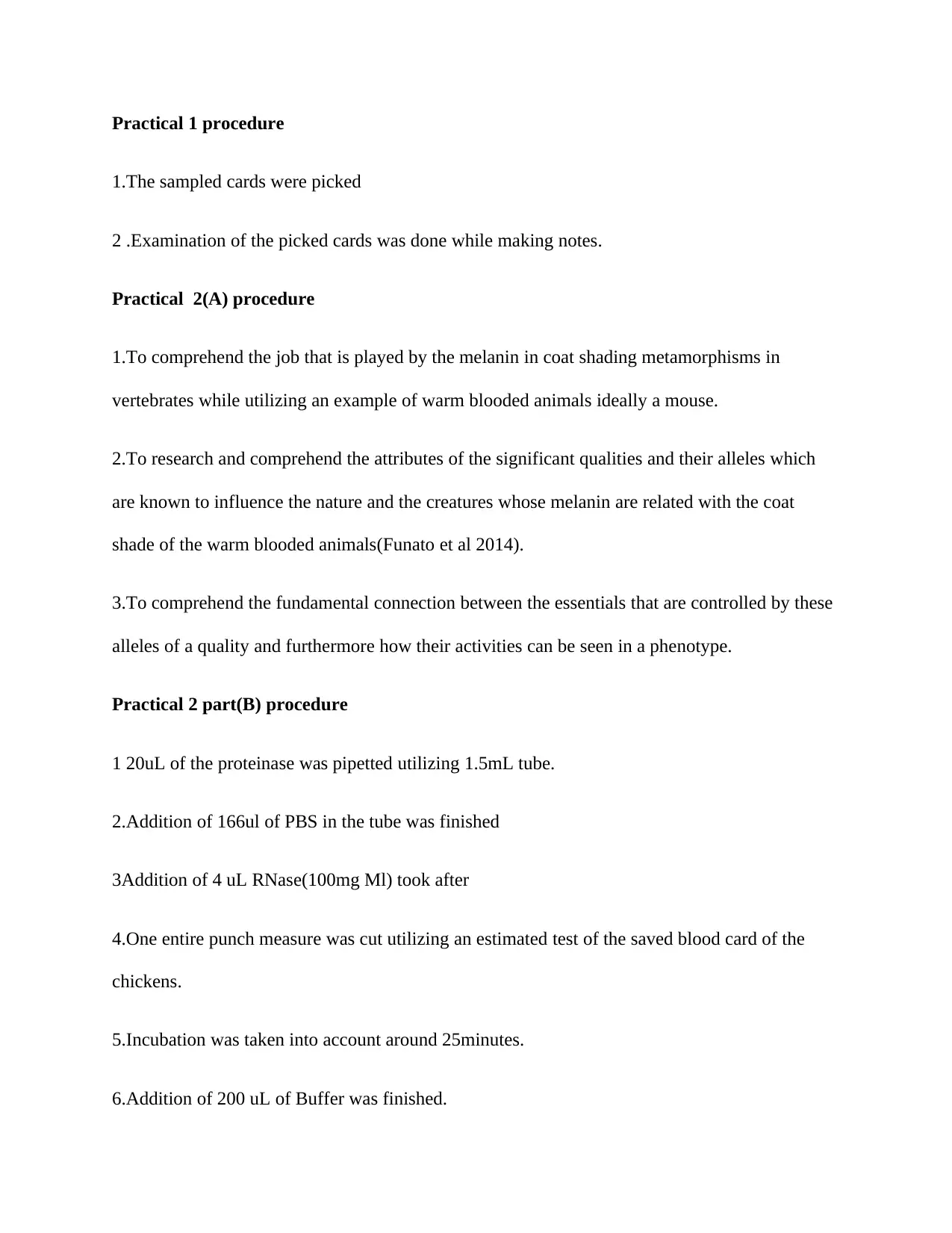
Practical 1 procedure
1.The sampled cards were picked
2 .Examination of the picked cards was done while making notes.
Practical 2(A) procedure
1.To comprehend the job that is played by the melanin in coat shading metamorphisms in
vertebrates while utilizing an example of warm blooded animals ideally a mouse.
2.To research and comprehend the attributes of the significant qualities and their alleles which
are known to influence the nature and the creatures whose melanin are related with the coat
shade of the warm blooded animals(Funato et al 2014).
3.To comprehend the fundamental connection between the essentials that are controlled by these
alleles of a quality and furthermore how their activities can be seen in a phenotype.
Practical 2 part(B) procedure
1 20uL of the proteinase was pipetted utilizing 1.5mL tube.
2.Addition of 166ul of PBS in the tube was finished
3Addition of 4 uL RNase(100mg Ml) took after
4.One entire punch measure was cut utilizing an estimated test of the saved blood card of the
chickens.
5.Incubation was taken into account around 25minutes.
6.Addition of 200 uL of Buffer was finished.
1.The sampled cards were picked
2 .Examination of the picked cards was done while making notes.
Practical 2(A) procedure
1.To comprehend the job that is played by the melanin in coat shading metamorphisms in
vertebrates while utilizing an example of warm blooded animals ideally a mouse.
2.To research and comprehend the attributes of the significant qualities and their alleles which
are known to influence the nature and the creatures whose melanin are related with the coat
shade of the warm blooded animals(Funato et al 2014).
3.To comprehend the fundamental connection between the essentials that are controlled by these
alleles of a quality and furthermore how their activities can be seen in a phenotype.
Practical 2 part(B) procedure
1 20uL of the proteinase was pipetted utilizing 1.5mL tube.
2.Addition of 166ul of PBS in the tube was finished
3Addition of 4 uL RNase(100mg Ml) took after
4.One entire punch measure was cut utilizing an estimated test of the saved blood card of the
chickens.
5.Incubation was taken into account around 25minutes.
6.Addition of 200 uL of Buffer was finished.
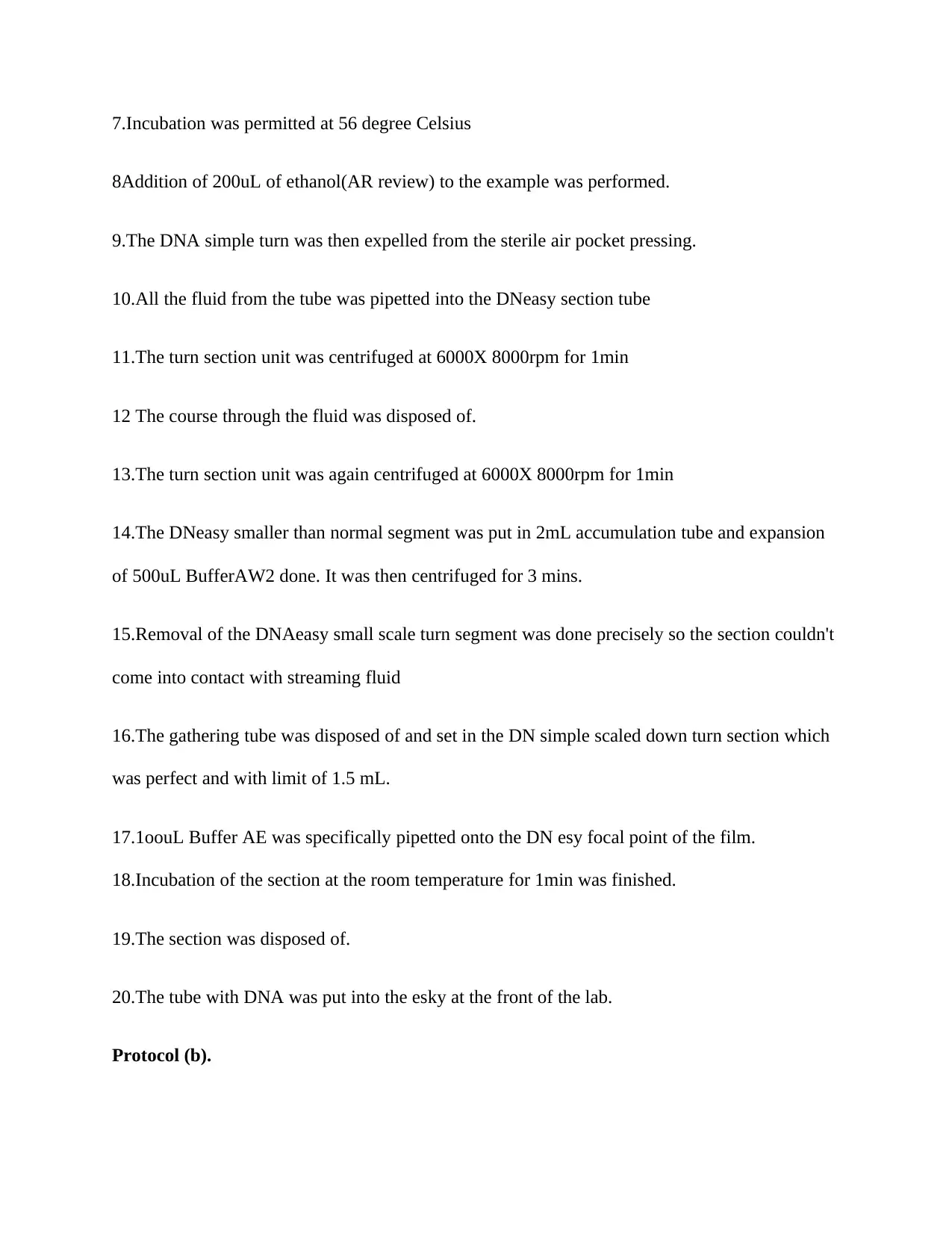
7.Incubation was permitted at 56 degree Celsius
8Addition of 200uL of ethanol(AR review) to the example was performed.
9.The DNA simple turn was then expelled from the sterile air pocket pressing.
10.All the fluid from the tube was pipetted into the DNeasy section tube
11.The turn section unit was centrifuged at 6000X 8000rpm for 1min
12 The course through the fluid was disposed of.
13.The turn section unit was again centrifuged at 6000X 8000rpm for 1min
14.The DNeasy smaller than normal segment was put in 2mL accumulation tube and expansion
of 500uL BufferAW2 done. It was then centrifuged for 3 mins.
15.Removal of the DNAeasy small scale turn segment was done precisely so the section couldn't
come into contact with streaming fluid
16.The gathering tube was disposed of and set in the DN simple scaled down turn section which
was perfect and with limit of 1.5 mL.
17.1oouL Buffer AE was specifically pipetted onto the DN esy focal point of the film.
18.Incubation of the section at the room temperature for 1min was finished.
19.The section was disposed of.
20.The tube with DNA was put into the esky at the front of the lab.
Protocol (b).
8Addition of 200uL of ethanol(AR review) to the example was performed.
9.The DNA simple turn was then expelled from the sterile air pocket pressing.
10.All the fluid from the tube was pipetted into the DNeasy section tube
11.The turn section unit was centrifuged at 6000X 8000rpm for 1min
12 The course through the fluid was disposed of.
13.The turn section unit was again centrifuged at 6000X 8000rpm for 1min
14.The DNeasy smaller than normal segment was put in 2mL accumulation tube and expansion
of 500uL BufferAW2 done. It was then centrifuged for 3 mins.
15.Removal of the DNAeasy small scale turn segment was done precisely so the section couldn't
come into contact with streaming fluid
16.The gathering tube was disposed of and set in the DN simple scaled down turn section which
was perfect and with limit of 1.5 mL.
17.1oouL Buffer AE was specifically pipetted onto the DN esy focal point of the film.
18.Incubation of the section at the room temperature for 1min was finished.
19.The section was disposed of.
20.The tube with DNA was put into the esky at the front of the lab.
Protocol (b).
⊘ This is a preview!⊘
Do you want full access?
Subscribe today to unlock all pages.

Trusted by 1+ million students worldwide
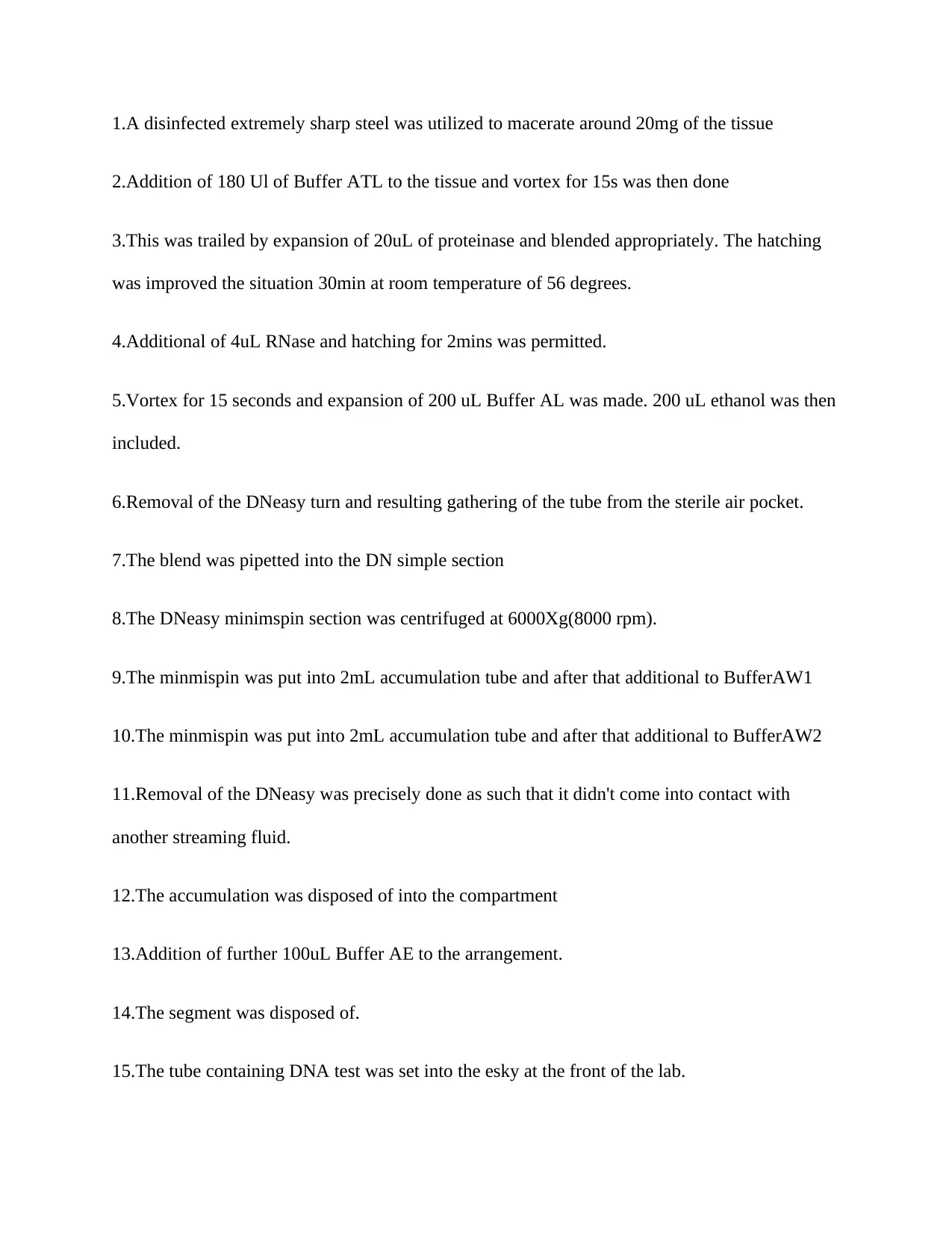
1.A disinfected extremely sharp steel was utilized to macerate around 20mg of the tissue
2.Addition of 180 Ul of Buffer ATL to the tissue and vortex for 15s was then done
3.This was trailed by expansion of 20uL of proteinase and blended appropriately. The hatching
was improved the situation 30min at room temperature of 56 degrees.
4.Additional of 4uL RNase and hatching for 2mins was permitted.
5.Vortex for 15 seconds and expansion of 200 uL Buffer AL was made. 200 uL ethanol was then
included.
6.Removal of the DNeasy turn and resulting gathering of the tube from the sterile air pocket.
7.The blend was pipetted into the DN simple section
8.The DNeasy minimspin section was centrifuged at 6000Xg(8000 rpm).
9.The minmispin was put into 2mL accumulation tube and after that additional to BufferAW1
10.The minmispin was put into 2mL accumulation tube and after that additional to BufferAW2
11.Removal of the DNeasy was precisely done as such that it didn't come into contact with
another streaming fluid.
12.The accumulation was disposed of into the compartment
13.Addition of further 100uL Buffer AE to the arrangement.
14.The segment was disposed of.
15.The tube containing DNA test was set into the esky at the front of the lab.
2.Addition of 180 Ul of Buffer ATL to the tissue and vortex for 15s was then done
3.This was trailed by expansion of 20uL of proteinase and blended appropriately. The hatching
was improved the situation 30min at room temperature of 56 degrees.
4.Additional of 4uL RNase and hatching for 2mins was permitted.
5.Vortex for 15 seconds and expansion of 200 uL Buffer AL was made. 200 uL ethanol was then
included.
6.Removal of the DNeasy turn and resulting gathering of the tube from the sterile air pocket.
7.The blend was pipetted into the DN simple section
8.The DNeasy minimspin section was centrifuged at 6000Xg(8000 rpm).
9.The minmispin was put into 2mL accumulation tube and after that additional to BufferAW1
10.The minmispin was put into 2mL accumulation tube and after that additional to BufferAW2
11.Removal of the DNeasy was precisely done as such that it didn't come into contact with
another streaming fluid.
12.The accumulation was disposed of into the compartment
13.Addition of further 100uL Buffer AE to the arrangement.
14.The segment was disposed of.
15.The tube containing DNA test was set into the esky at the front of the lab.
Paraphrase This Document
Need a fresh take? Get an instant paraphrase of this document with our AI Paraphraser
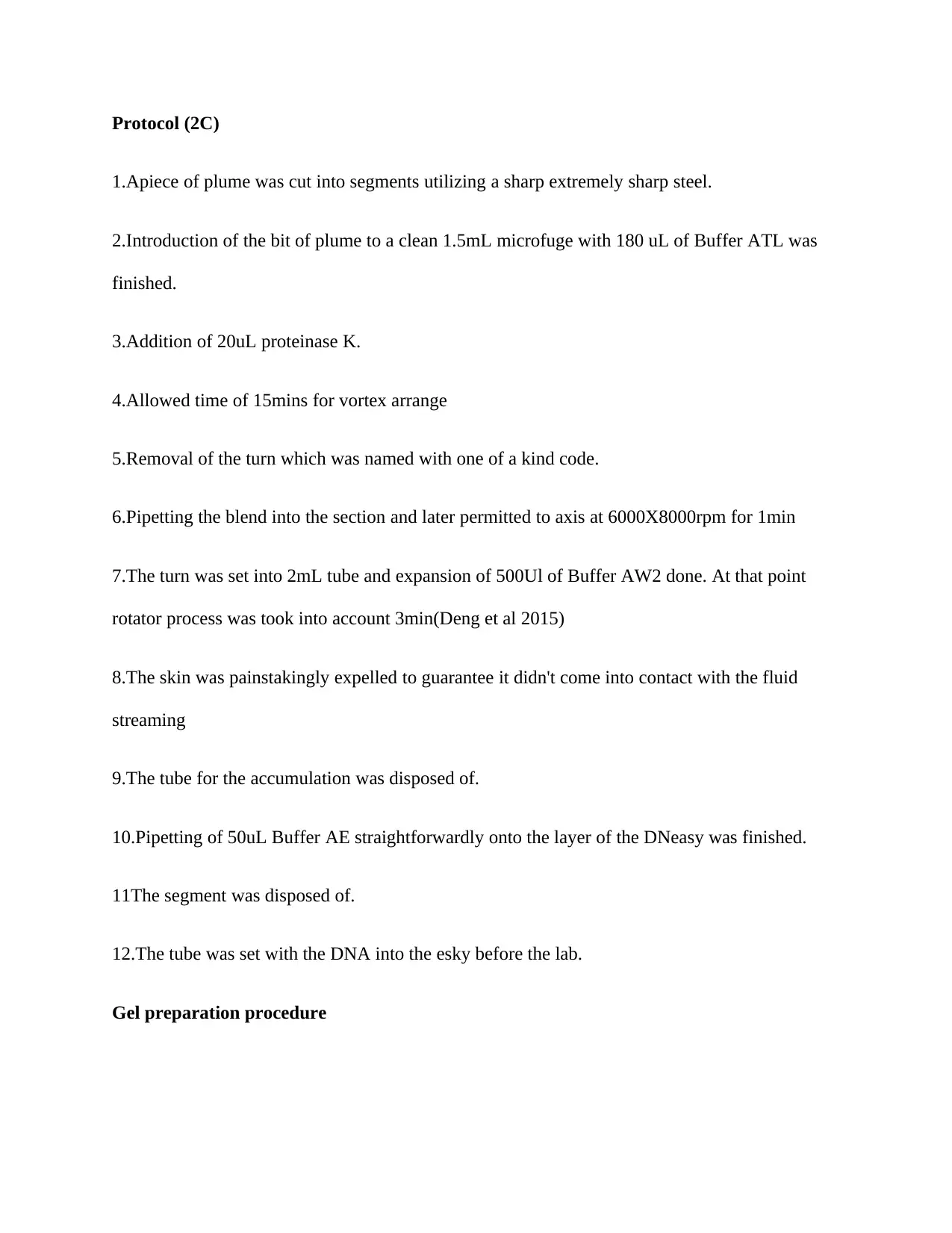
Protocol (2C)
1.Apiece of plume was cut into segments utilizing a sharp extremely sharp steel.
2.Introduction of the bit of plume to a clean 1.5mL microfuge with 180 uL of Buffer ATL was
finished.
3.Addition of 20uL proteinase K.
4.Allowed time of 15mins for vortex arrange
5.Removal of the turn which was named with one of a kind code.
6.Pipetting the blend into the section and later permitted to axis at 6000X8000rpm for 1min
7.The turn was set into 2mL tube and expansion of 500Ul of Buffer AW2 done. At that point
rotator process was took into account 3min(Deng et al 2015)
8.The skin was painstakingly expelled to guarantee it didn't come into contact with the fluid
streaming
9.The tube for the accumulation was disposed of.
10.Pipetting of 50uL Buffer AE straightforwardly onto the layer of the DNeasy was finished.
11The segment was disposed of.
12.The tube was set with the DNA into the esky before the lab.
Gel preparation procedure
1.Apiece of plume was cut into segments utilizing a sharp extremely sharp steel.
2.Introduction of the bit of plume to a clean 1.5mL microfuge with 180 uL of Buffer ATL was
finished.
3.Addition of 20uL proteinase K.
4.Allowed time of 15mins for vortex arrange
5.Removal of the turn which was named with one of a kind code.
6.Pipetting the blend into the section and later permitted to axis at 6000X8000rpm for 1min
7.The turn was set into 2mL tube and expansion of 500Ul of Buffer AW2 done. At that point
rotator process was took into account 3min(Deng et al 2015)
8.The skin was painstakingly expelled to guarantee it didn't come into contact with the fluid
streaming
9.The tube for the accumulation was disposed of.
10.Pipetting of 50uL Buffer AE straightforwardly onto the layer of the DNeasy was finished.
11The segment was disposed of.
12.The tube was set with the DNA into the esky before the lab.
Gel preparation procedure
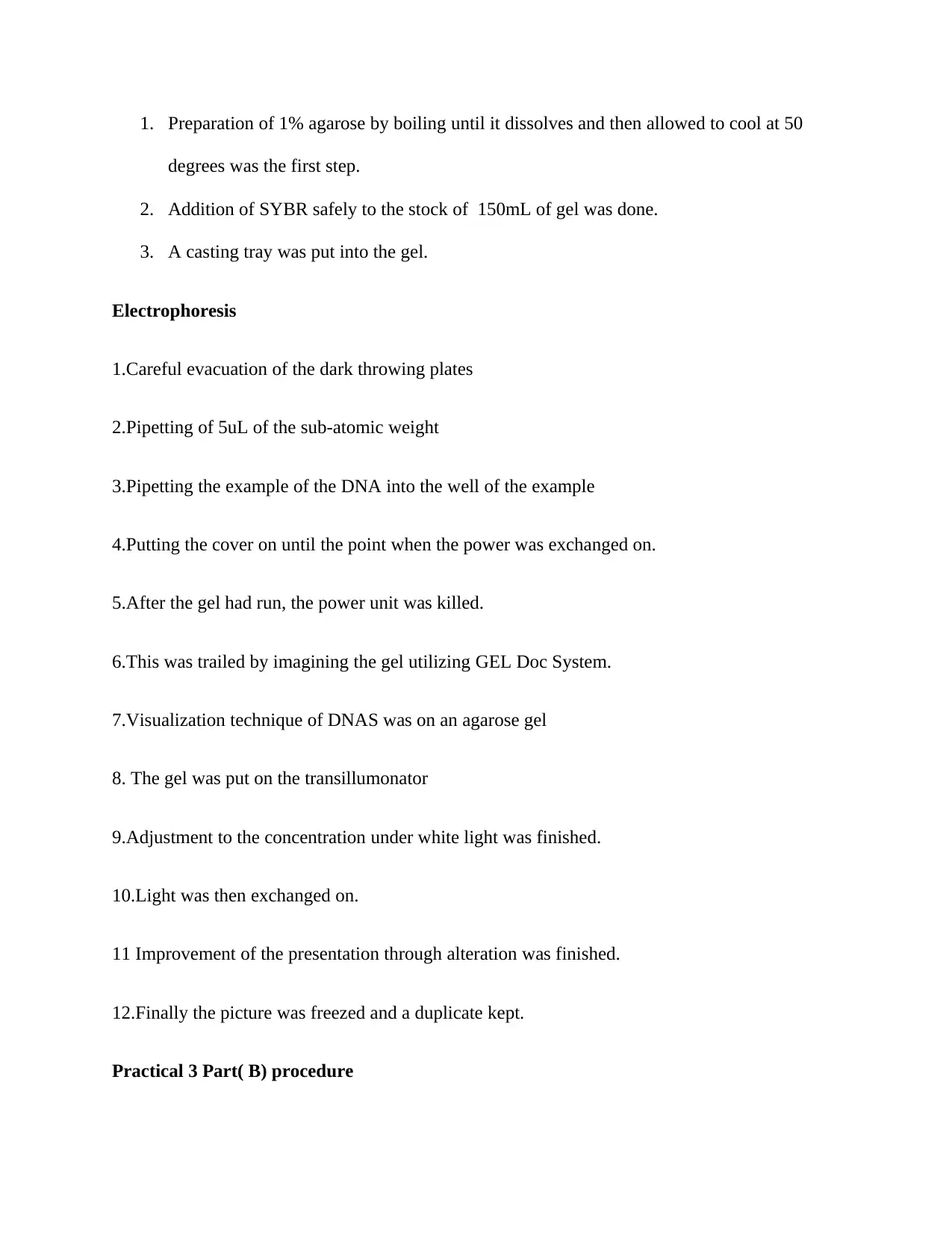
1. Preparation of 1% agarose by boiling until it dissolves and then allowed to cool at 50
degrees was the first step.
2. Addition of SYBR safely to the stock of 150mL of gel was done.
3. A casting tray was put into the gel.
Electrophoresis
1.Careful evacuation of the dark throwing plates
2.Pipetting of 5uL of the sub-atomic weight
3.Pipetting the example of the DNA into the well of the example
4.Putting the cover on until the point when the power was exchanged on.
5.After the gel had run, the power unit was killed.
6.This was trailed by imagining the gel utilizing GEL Doc System.
7.Visualization technique of DNAS was on an agarose gel
8. The gel was put on the transillumonator
9.Adjustment to the concentration under white light was finished.
10.Light was then exchanged on.
11 Improvement of the presentation through alteration was finished.
12.Finally the picture was freezed and a duplicate kept.
Practical 3 Part( B) procedure
degrees was the first step.
2. Addition of SYBR safely to the stock of 150mL of gel was done.
3. A casting tray was put into the gel.
Electrophoresis
1.Careful evacuation of the dark throwing plates
2.Pipetting of 5uL of the sub-atomic weight
3.Pipetting the example of the DNA into the well of the example
4.Putting the cover on until the point when the power was exchanged on.
5.After the gel had run, the power unit was killed.
6.This was trailed by imagining the gel utilizing GEL Doc System.
7.Visualization technique of DNAS was on an agarose gel
8. The gel was put on the transillumonator
9.Adjustment to the concentration under white light was finished.
10.Light was then exchanged on.
11 Improvement of the presentation through alteration was finished.
12.Finally the picture was freezed and a duplicate kept.
Practical 3 Part( B) procedure
⊘ This is a preview!⊘
Do you want full access?
Subscribe today to unlock all pages.

Trusted by 1+ million students worldwide
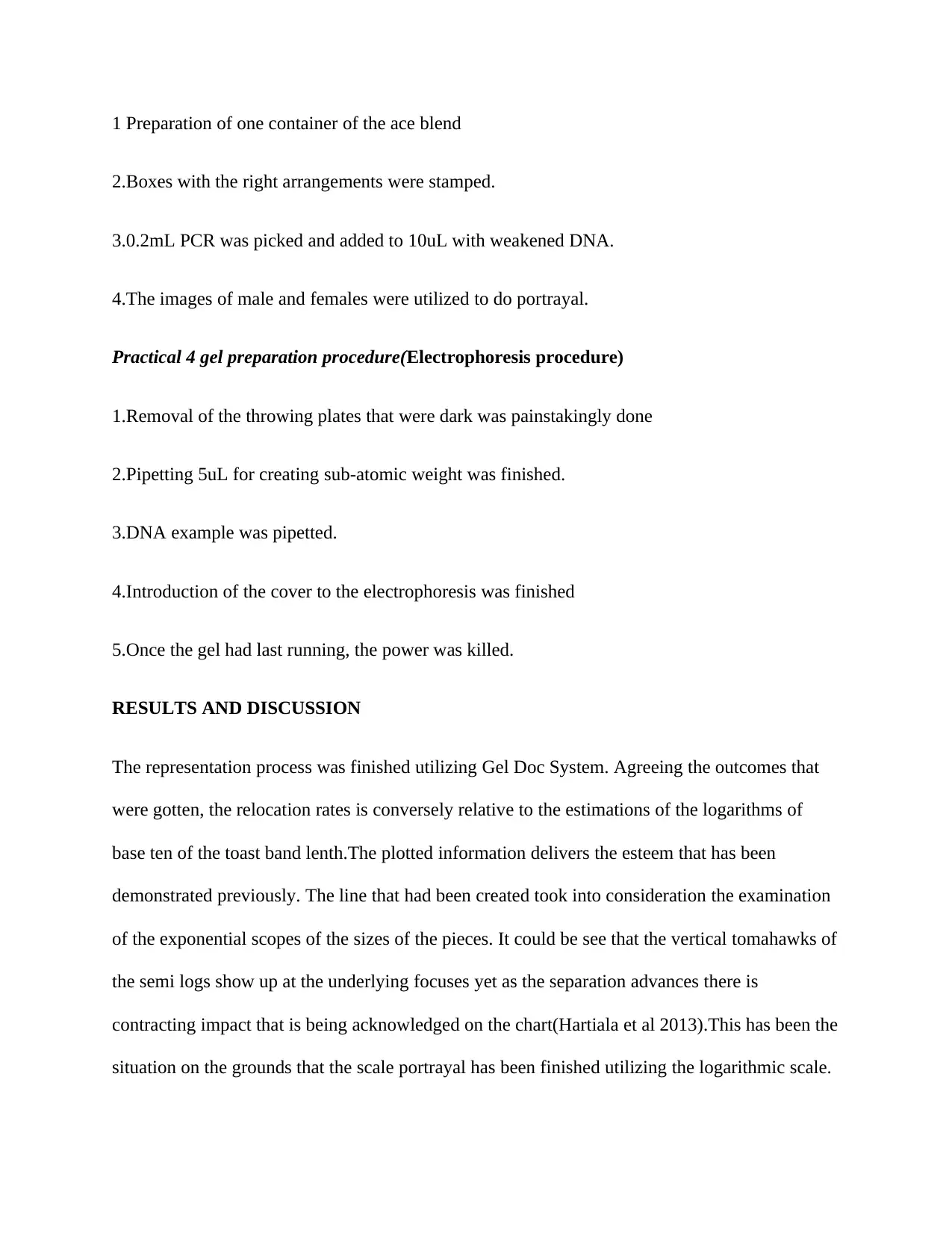
1 Preparation of one container of the ace blend
2.Boxes with the right arrangements were stamped.
3.0.2mL PCR was picked and added to 10uL with weakened DNA.
4.The images of male and females were utilized to do portrayal.
Practical 4 gel preparation procedure(Electrophoresis procedure)
1.Removal of the throwing plates that were dark was painstakingly done
2.Pipetting 5uL for creating sub-atomic weight was finished.
3.DNA example was pipetted.
4.Introduction of the cover to the electrophoresis was finished
5.Once the gel had last running, the power was killed.
RESULTS AND DISCUSSION
The representation process was finished utilizing Gel Doc System. Agreeing the outcomes that
were gotten, the relocation rates is conversely relative to the estimations of the logarithms of
base ten of the toast band lenth.The plotted information delivers the esteem that has been
demonstrated previously. The line that had been created took into consideration the examination
of the exponential scopes of the sizes of the pieces. It could be see that the vertical tomahawks of
the semi logs show up at the underlying focuses yet as the separation advances there is
contracting impact that is being acknowledged on the chart(Hartiala et al 2013).This has been the
situation on the grounds that the scale portrayal has been finished utilizing the logarithmic scale.
2.Boxes with the right arrangements were stamped.
3.0.2mL PCR was picked and added to 10uL with weakened DNA.
4.The images of male and females were utilized to do portrayal.
Practical 4 gel preparation procedure(Electrophoresis procedure)
1.Removal of the throwing plates that were dark was painstakingly done
2.Pipetting 5uL for creating sub-atomic weight was finished.
3.DNA example was pipetted.
4.Introduction of the cover to the electrophoresis was finished
5.Once the gel had last running, the power was killed.
RESULTS AND DISCUSSION
The representation process was finished utilizing Gel Doc System. Agreeing the outcomes that
were gotten, the relocation rates is conversely relative to the estimations of the logarithms of
base ten of the toast band lenth.The plotted information delivers the esteem that has been
demonstrated previously. The line that had been created took into consideration the examination
of the exponential scopes of the sizes of the pieces. It could be see that the vertical tomahawks of
the semi logs show up at the underlying focuses yet as the separation advances there is
contracting impact that is being acknowledged on the chart(Hartiala et al 2013).This has been the
situation on the grounds that the scale portrayal has been finished utilizing the logarithmic scale.
Paraphrase This Document
Need a fresh take? Get an instant paraphrase of this document with our AI Paraphraser
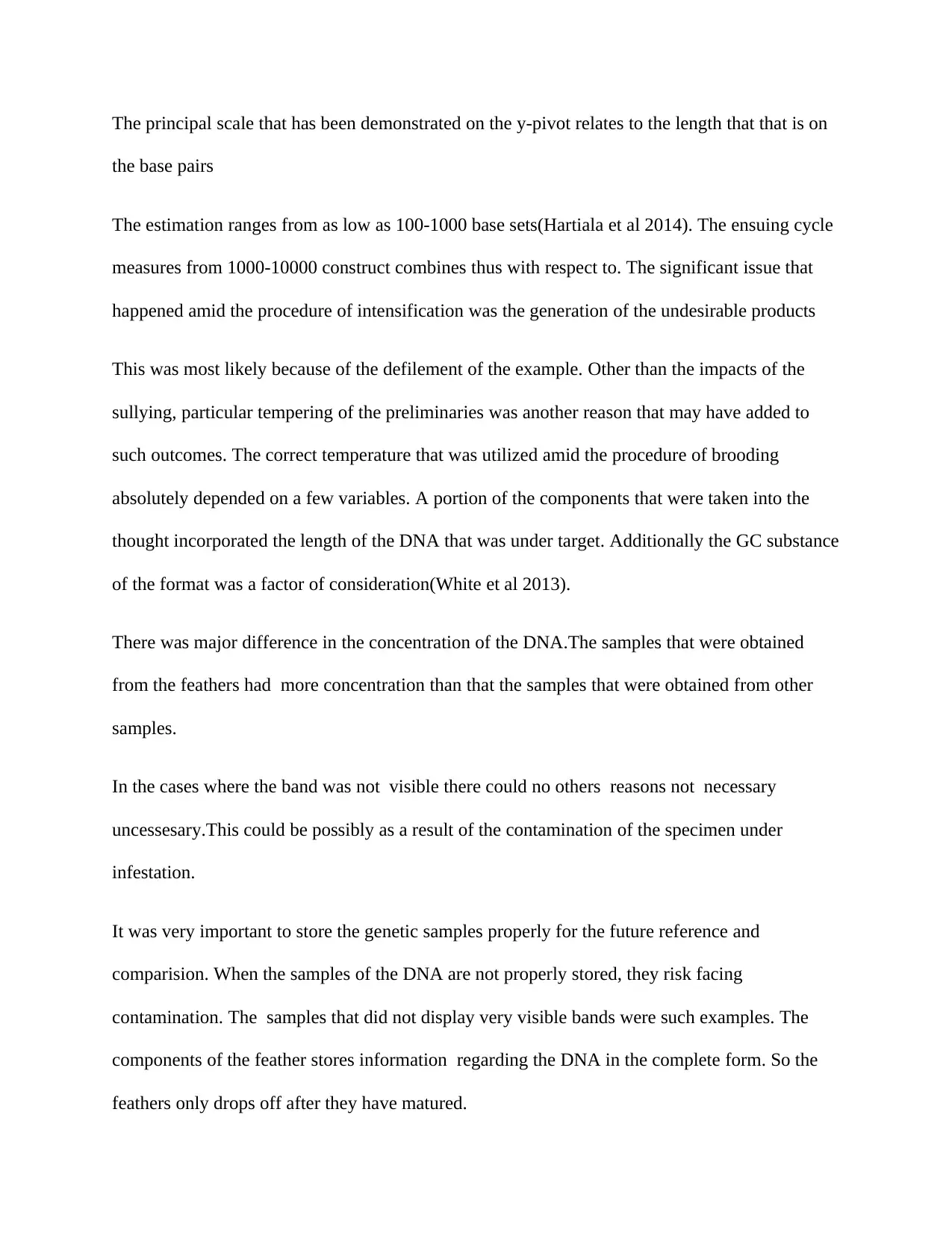
The principal scale that has been demonstrated on the y-pivot relates to the length that that is on
the base pairs
The estimation ranges from as low as 100-1000 base sets(Hartiala et al 2014). The ensuing cycle
measures from 1000-10000 construct combines thus with respect to. The significant issue that
happened amid the procedure of intensification was the generation of the undesirable products
This was most likely because of the defilement of the example. Other than the impacts of the
sullying, particular tempering of the preliminaries was another reason that may have added to
such outcomes. The correct temperature that was utilized amid the procedure of brooding
absolutely depended on a few variables. A portion of the components that were taken into the
thought incorporated the length of the DNA that was under target. Additionally the GC substance
of the format was a factor of consideration(White et al 2013).
There was major difference in the concentration of the DNA.The samples that were obtained
from the feathers had more concentration than that the samples that were obtained from other
samples.
In the cases where the band was not visible there could no others reasons not necessary
uncessesary.This could be possibly as a result of the contamination of the specimen under
infestation.
It was very important to store the genetic samples properly for the future reference and
comparision. When the samples of the DNA are not properly stored, they risk facing
contamination. The samples that did not display very visible bands were such examples. The
components of the feather stores information regarding the DNA in the complete form. So the
feathers only drops off after they have matured.
the base pairs
The estimation ranges from as low as 100-1000 base sets(Hartiala et al 2014). The ensuing cycle
measures from 1000-10000 construct combines thus with respect to. The significant issue that
happened amid the procedure of intensification was the generation of the undesirable products
This was most likely because of the defilement of the example. Other than the impacts of the
sullying, particular tempering of the preliminaries was another reason that may have added to
such outcomes. The correct temperature that was utilized amid the procedure of brooding
absolutely depended on a few variables. A portion of the components that were taken into the
thought incorporated the length of the DNA that was under target. Additionally the GC substance
of the format was a factor of consideration(White et al 2013).
There was major difference in the concentration of the DNA.The samples that were obtained
from the feathers had more concentration than that the samples that were obtained from other
samples.
In the cases where the band was not visible there could no others reasons not necessary
uncessesary.This could be possibly as a result of the contamination of the specimen under
infestation.
It was very important to store the genetic samples properly for the future reference and
comparision. When the samples of the DNA are not properly stored, they risk facing
contamination. The samples that did not display very visible bands were such examples. The
components of the feather stores information regarding the DNA in the complete form. So the
feathers only drops off after they have matured.
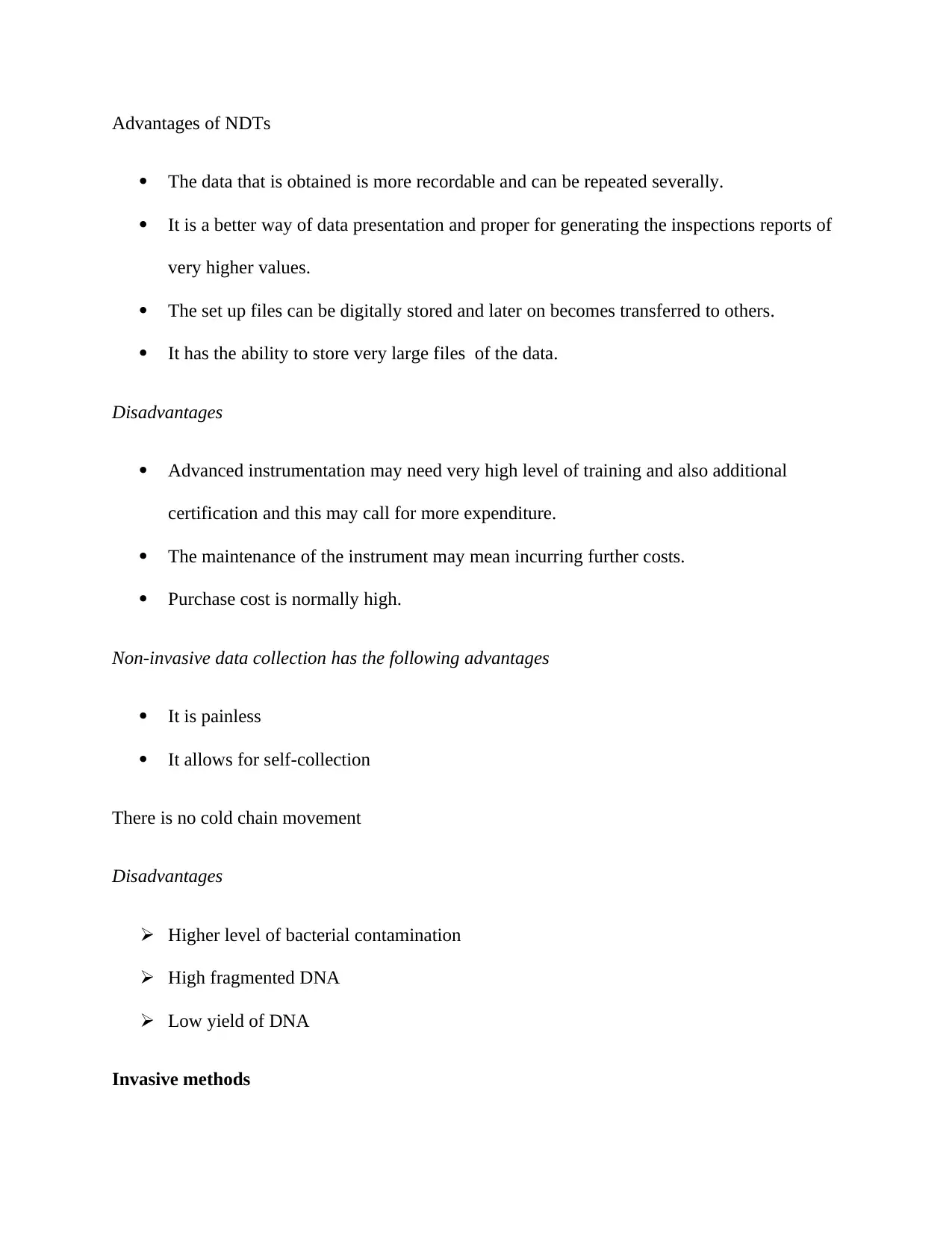
Advantages of NDTs
The data that is obtained is more recordable and can be repeated severally.
It is a better way of data presentation and proper for generating the inspections reports of
very higher values.
The set up files can be digitally stored and later on becomes transferred to others.
It has the ability to store very large files of the data.
Disadvantages
Advanced instrumentation may need very high level of training and also additional
certification and this may call for more expenditure.
The maintenance of the instrument may mean incurring further costs.
Purchase cost is normally high.
Non-invasive data collection has the following advantages
It is painless
It allows for self-collection
There is no cold chain movement
Disadvantages
Higher level of bacterial contamination
High fragmented DNA
Low yield of DNA
Invasive methods
The data that is obtained is more recordable and can be repeated severally.
It is a better way of data presentation and proper for generating the inspections reports of
very higher values.
The set up files can be digitally stored and later on becomes transferred to others.
It has the ability to store very large files of the data.
Disadvantages
Advanced instrumentation may need very high level of training and also additional
certification and this may call for more expenditure.
The maintenance of the instrument may mean incurring further costs.
Purchase cost is normally high.
Non-invasive data collection has the following advantages
It is painless
It allows for self-collection
There is no cold chain movement
Disadvantages
Higher level of bacterial contamination
High fragmented DNA
Low yield of DNA
Invasive methods
⊘ This is a preview!⊘
Do you want full access?
Subscribe today to unlock all pages.

Trusted by 1+ million students worldwide
1 out of 19
Your All-in-One AI-Powered Toolkit for Academic Success.
+13062052269
info@desklib.com
Available 24*7 on WhatsApp / Email
![[object Object]](/_next/static/media/star-bottom.7253800d.svg)
Unlock your academic potential
Copyright © 2020–2025 A2Z Services. All Rights Reserved. Developed and managed by ZUCOL.
